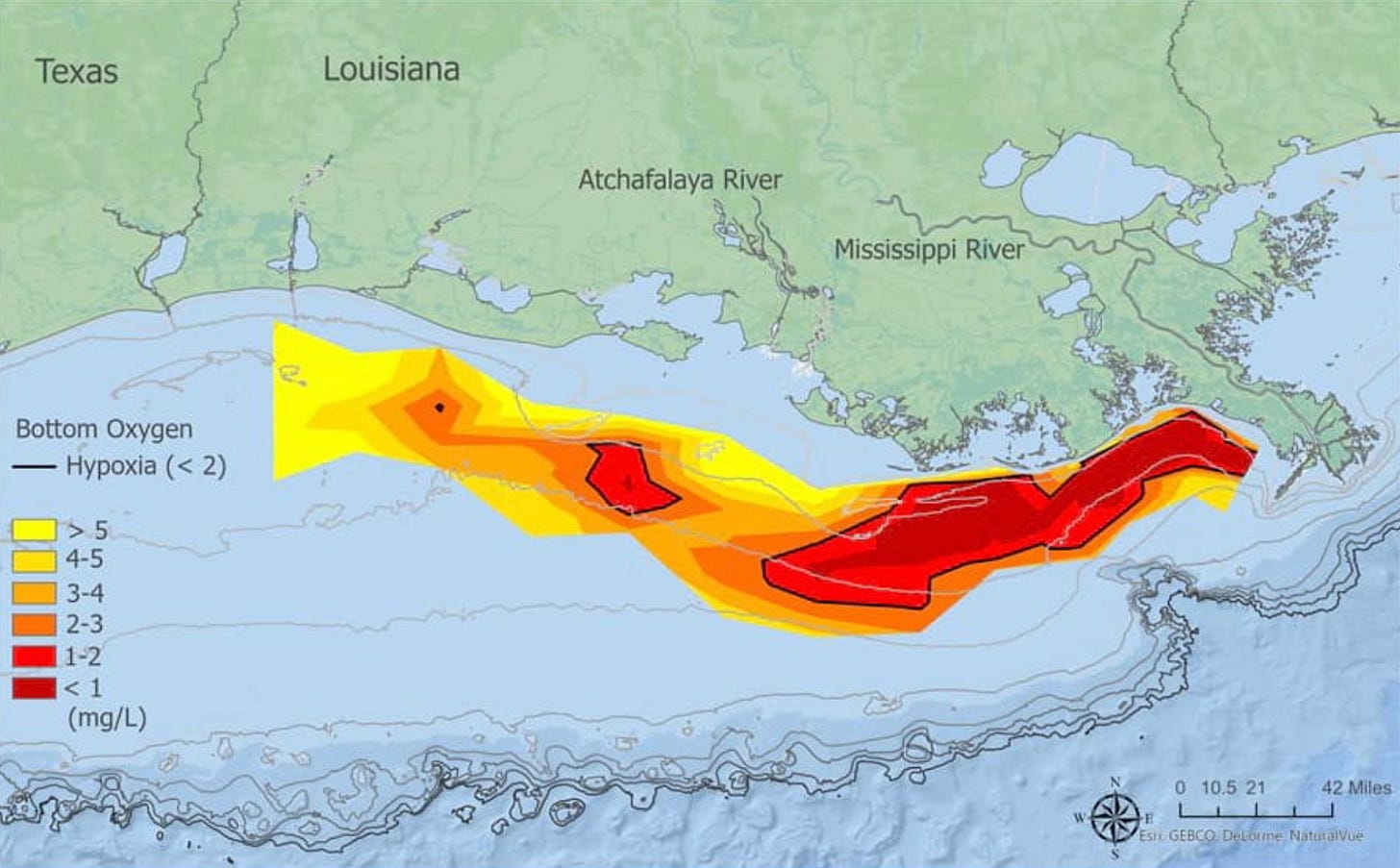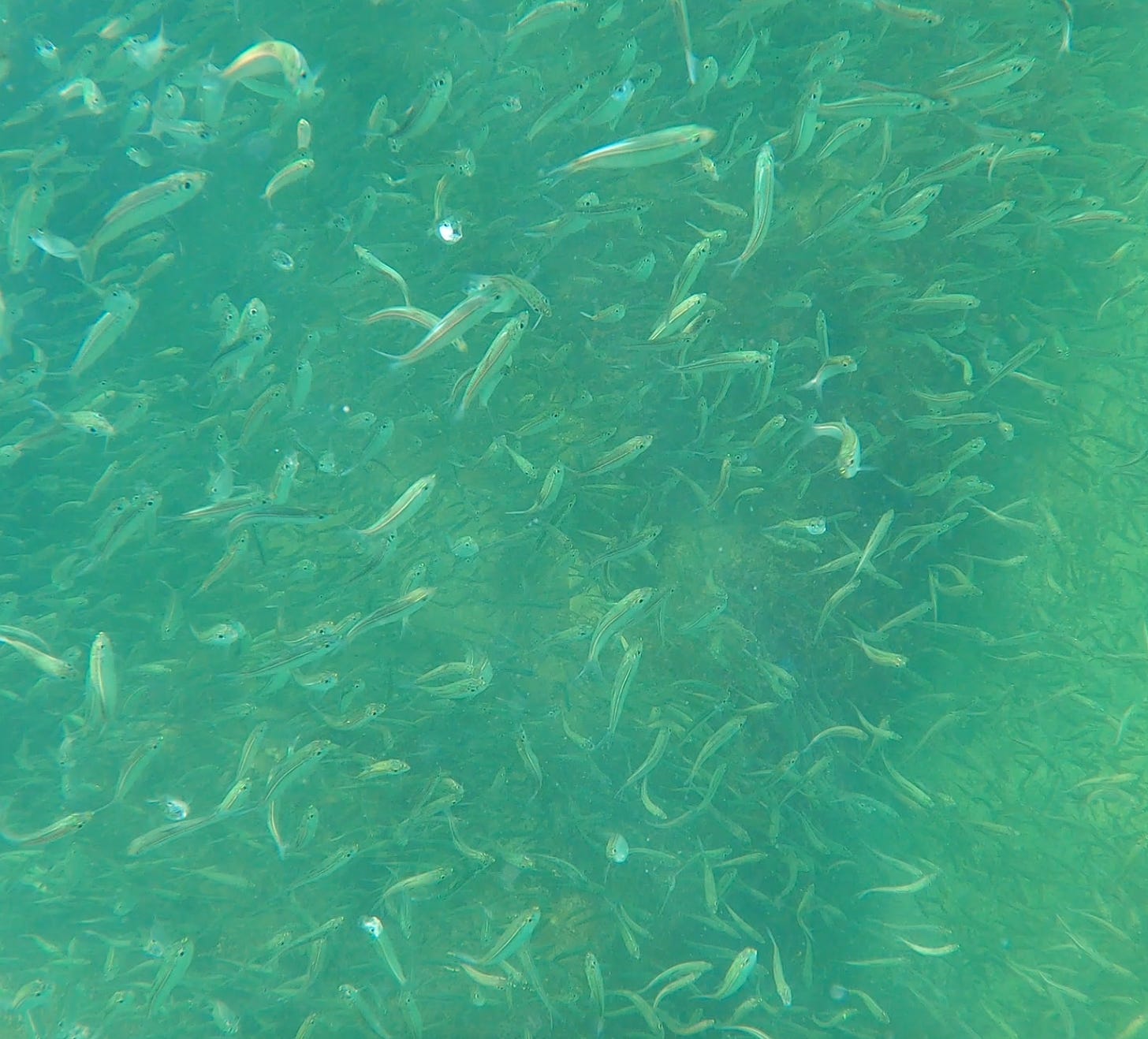How Regenerative Agriculture Can Fix Ocean Dead Zones
The unlikely solution to the US’s most quiet environmental disaster
Agricultural runoff from industrial-scale farms is causing algae blooms and subsequent zero-oxygen dead zones in the Gulf of Mexico
Regenerative agriculture, a holistic alternative to industrial farming, keeps nutrients in the soil (and out of the ocean)
Nutrient Pollution
Nutrient pollution is the United States’ most pressing environmental issue. The economic implications on our fisheries and coastal habitats are massive. But, nobody is talking about it as it occurs beneath the ocean’s surface, out of sight.
How it works
Agricultural runoff from industrial-scale farming leaks into the Mississippi River, ultimately entering the ocean in the Gulf of Mexico. Here the runoff, rich in ‘plant food’ from fertilizers, feeds microscopic ocean plants (microalgae).
We call this accumulation of nutrients, eutrophication.
The algae blooms, and when the runoff input seasonally ends, it dies en-masse. As the mass of algae decomposes, it rips oxygen out of the water column, killing all nearby marine life–creating ‘dead zones’: vast hectares of ocean completely devoid of oxygen, and by extension, marine life.
Photo Credit: Tom El-Sahieh (cropped)
Ocean dead zones in the Gulf of Mexico are an environmental catastrophe. Anyone who’s dived the Gulf like I have will tell you that it is remarkably full of life. While the water is not as clear as, let’s say, the tropical Atlantic, it is naturally very high in nutrients.
These nutrients feed so many phytoplankton and zooplankton that this is exactly the reason why the water is so murky. It’s full of microscopic life!
This microscopic life is the beginning of a highly productive food web. As a spearfisherman, I can vouch that the fishery here is unbelievably healthy. There are just so many fish! The waters are gorgeous to dive if you’re willing to sift through some murkiness.
Here’s a point of view from my GoPro. You can hardly see the shipwreck because of so many baitfish in the way!
Where there’s already high nutrients, messing with the natural balance by adding further nutrients from agricultural runoff leads to disaster.
Industrial agriculture is (mostly) to blame.
Monocropping, meaning the growing and harvesting of single crops at a time in massive fields (sugarcane, soybeans, corn), is a destructive agricultural practice. Natural ecosystems are used to balancing thousands of plant, animal, and microbial species at a time. Simply growing one crop is unnatural and requires constant synthetic fertilizer inputs, which only damages the soil over time. Pushed into the waterways by rainfall, these are the nutrients leading to dead zones in the ocean.
Industrial agriculture also includes animal agriculture. Concentrated Animal Feeding Operations (CAFOs) refer to the industrial scale, tight space, animal abuse-riddled production of cows, pigs, and chickens.
These facilities can be immensely polluting as discharge from manure and wastewater, improperly stored, leaks into waterways as well. This discharge consists of nitrogen, phosphorus, as well as antibiotics, hormones, and pathogens…yuck!
Stormwater, wastewater, and combusting fossil fuels are also contributing factors, but industrial plant and animal agriculture is the main culprit.
How do we fix nutrient pollution-created dead zones in the Gulf of Mexico?
The most sensible solution is likely to go up the Mississippi river to the nutrient source. Here, the systematic solution would be to completely reinvent our food system by transitioning from industrial agriculture to regenerative agriculture.
Regenerative agriculture is “a holistic approach to agriculture that focuses on the interconnection of farming systems and the ecological system as a whole” (cbf.org).
Regenerative agriculture is all about soil health.
Regenerative farmers:
Use diverse crop rotation to diversify the microbes in soil
Grow many fruit/vegetable/nut species at once for the same reason
Enforce no/low till farming to minimize disturbance, maximizing soil microbial populations
Utilize rotational grazing by e.g. cows to strengthen the toughest plant roots and break down the weakest ones for soil microbes to break down further and absorb.
Nevertheless, regenerative farmers face serious challenges:
It’s initially very expensive and overwhelming. Having to buy a diverse range of seeds and spend extra cash on cover crops, which cover soil to keep it shaded, racks up.
Each farm is different and requires its own unique assessment to facilitate its transition.
Data aggregation and collaboration: "Pilot projects are often too proprietary and we tend to forget that it takes a long time to proof new concepts" (greenbiz.com)
The ROIs for the farmer only happens over time. Poorly managed monocrop soils take years to rejuvenate through regenerative practices.
One interesting startup in this space is ReNature. They help farmers around the globe make the transition to regenerative agriculture while also helping them quantify their CO2 sequestration.
For consumers -at least those of us in privileged positions -can support regenerative farmers by choosing to purchase organic fruits and veggies as well as grass-fed, pasture raised animal products. The health benefits are clear. It’s worth it if you can afford it.
While there are other notable solutions in the fight against nutrient pollution such as improved wastewater treatment and discharge (both tech + legislation are necessary here), the most obvious way of avoiding nutrients leaking into waterways is to keep it in the soil.
Adjusting completely from industrial agriculture to regenerative might never happen. The demand for food in areas of high population density like cities makes that hard from a time, space, and economic standpoint.
But if we can scale regenerative agriculture to whatever its theoretical maximum, I’m starting to believe that dead zones in the Gulf of Mexico could shrink proportionately.










